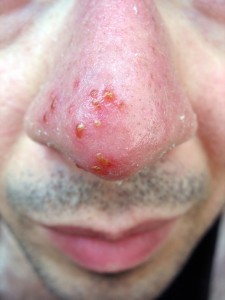 Cold sores, sometimes referred to as fever blisters, are painful and highly contagious blisters caused by the herpes simplex virus. There are two types of the virus that cause blisters, type 1 more often than type 2, but the blisters from both viruses are equally miserable. The blisters are filled with fluid and typically last around 2-3 weeks, though some people endure them for quite a bit longer.
Cold sores, sometimes referred to as fever blisters, are painful and highly contagious blisters caused by the herpes simplex virus. There are two types of the virus that cause blisters, type 1 more often than type 2, but the blisters from both viruses are equally miserable. The blisters are filled with fluid and typically last around 2-3 weeks, though some people endure them for quite a bit longer.
Cold sores are most commonly spread by direct skin contact such as through kissing, but can also be spread indirectly by sharing utensils, lip balms or towels.
Cold Sore Symptoms
A lot of people contract the herpes simplex virus and never actually get cold sores. Unfortunately, the asymptomatic person can still transmit the virus.
For those who do get cold sores, there are three main stages to a flare up:
First is a burning, tingling or itching sensation. This can last anywhere from a couple of hours to a couple of days. Not everyone gets this warning, but for those who do, it is the best time to apply antiviral creams that can stop the blister before it forms. You can find antiviral cream at any pharmacy.
The second stage is when the blisters start to pop up. Most blisters show up around the lips, but can also appear on your cheeks or near your nose. At this point, antiviral cream isn’t going to help near as much as it would have earlier. Try an anesthetic ointment with benzocaine, like those gels made for toothache pain.
During the third and final stage, the blisters erupt and fluid begins to seep and dry into a crust. At this point, the sore will heal in around two weeks. Leave it alone, though, or you risk prolonging the healing process and you could even introduce infection-causing bacteria.
Some people don’t realize it, but you are contagious from the very first tingle until the blister is completely healed. Not only can you spread the virus to others, but if you squeeze or pick at the blister, you can even cause yourself more blisters. Don’t touch it, and if you do touch it, wash your hands. You should even consider changing your toothbrush after the blisters heal, or at least sterilizing your toothbrush thoroughly.
People who have recently contracted the virus may develop other symptoms with their first few outbreaks, including sore throat, swollen lymph nodes, muscle aches or fever.
Children who contract the virus may also start to drool before a blister pops up. It is especially critical to keep children from touching their sores because they can spread the virus to their eyes, causing potentially serious complications.
How to Handle Cold Sores
If you feel the tell-tale tingle, take a natural supplement like Herdox. If you get frequent outbreaks, consider talking to your doctor about a daily antiviral medication that can help prevent cold sores.
The absolute best way to manage a cold sore is not to get it in the first place. Stress is a known trigger, so reduce stress and consider adding a B complex vitamin as B vitamins have been shown to lower stress. Boost your immune system with Vitamin C and garlic, as a strong immune system is better able to combat the virus. Acidic foods and Arginine are both important to the ability of the virus to replicate, so reducing acidic foods and foods containing Arginine will help reduce flare ups.